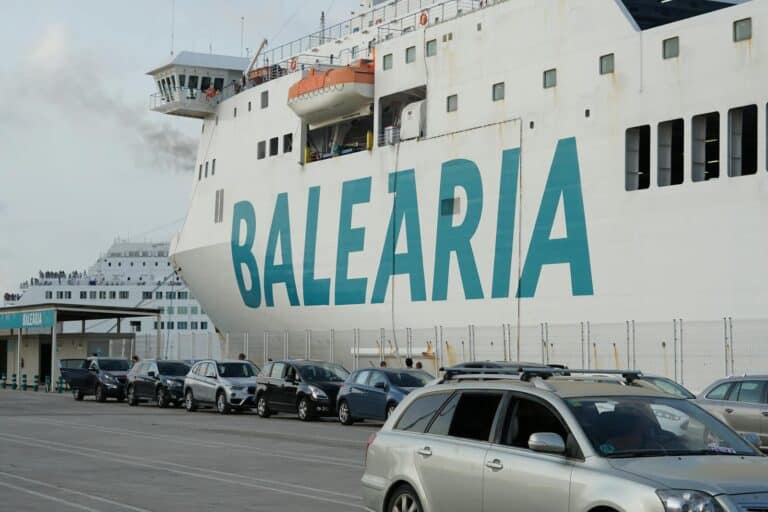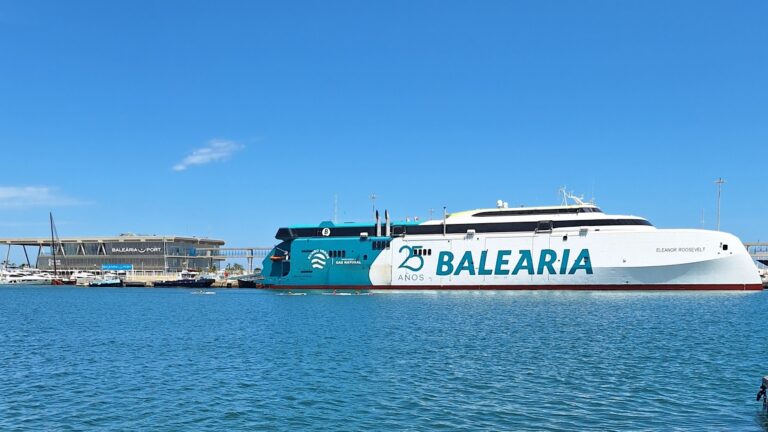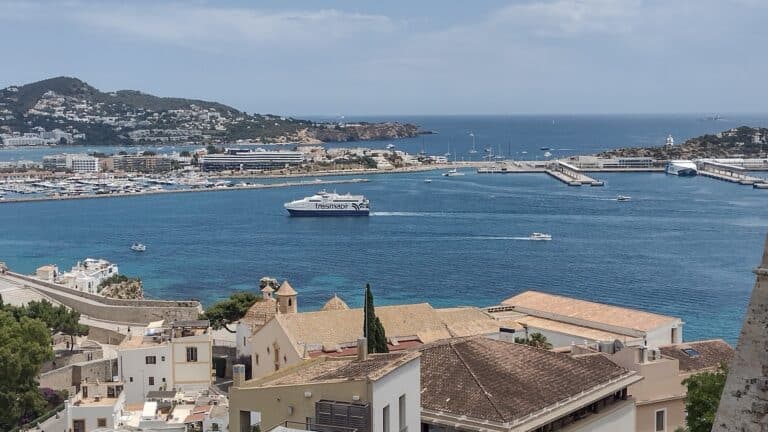Ibiza-Denia Ferry
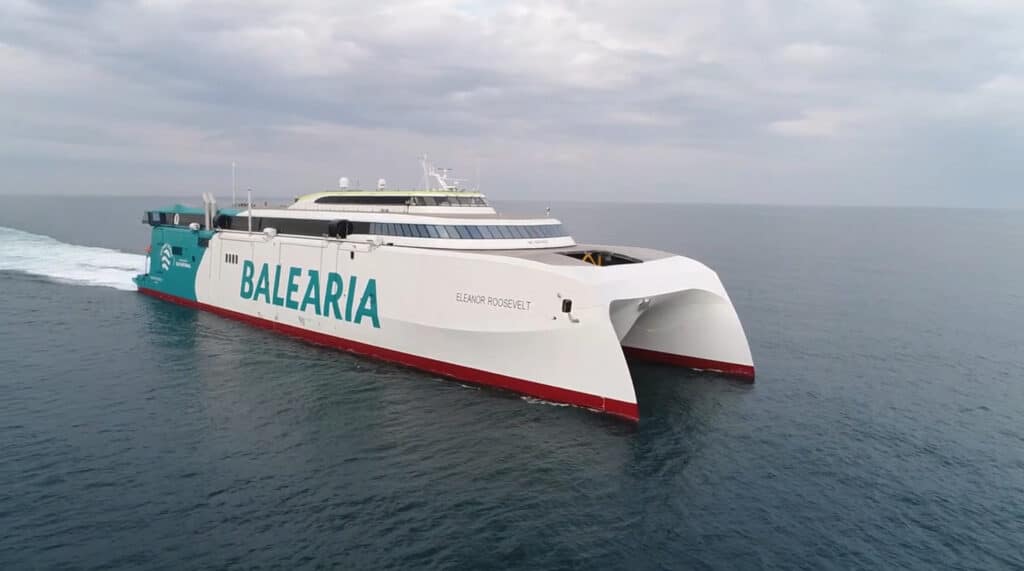
My first ferry trip between Ibiza and Denia turned my perception of sea travel upside down. Instead of the expected boring crossing, I got a mini-cruise with stunning views of the Mediterranean Sea and comfort one can only dream of. A trip on the Ibiza Denia ferry needs to be planned in advance. Especially in 2025, when the route has become even more popular.
The journey takes about 3-4 hours. Long? Actually, time on the ferry flies by unnoticed. While a plane is just taking off, you’ll already be enjoying the sea breeze on the open deck.
For me, the answer is obvious. Air travel between the islands and the mainland is pure hustle: check-in two hours before, queues at security, baggage restrictions. On the ferry, you can take as much as you can carry. Even a whole suitcase of wine from Denia! Plus, ferry tickets are on average 30-40% cheaper than airfare, especially if booked 2-3 months in advance. According to Balearia, in 2025 the average savings is about 50 euros per person one way.
Ibiza-Denia Ferry Schedule for 2025 (carriers Balearia and Trasmed GLE)
| Period | Company | Departure | Arrival | Duration |
|---|---|---|---|---|
| January-March | Balearia | 11:00 | 13:15 | 2h 15min |
| Trasmed GLE | 22:31 | 05:15 | 6h 44min | |
| April-May | Balearia | 11:00 | 13:15 | 2h 15min |
| Balearia | 21:00 | 23:15 | 2h 15min | |
| Trasmed GLE | 22:31 | 05:15 | 6h 44min | |
| June-October | Balearia | 11:00 | 13:15 | 2h 15min |
| Balearia | 13:00 | 15:15 | 2h 15min | |
| Balearia | 21:00 | 23:15 | 2h 15min | |
| Trasmed GLE | 22:31 | 05:15 | 6h 44min | |
| November-December | Balearia | 11:00 | 13:15 | 2h 15min |
| Trasmed GLE | 22:31 | 05:15 | 6h 44min |
Notes on the schedule:
- Balearia offers high-speed routes lasting 2 hours and 15 minutes.
- Trasmed GLE operates night routes with a stop in Formentera, which increases the travel time to 6 hours and 44 minutes.
- Trasmed GLE operates on specific days of the week (Monday, Wednesday, Thursday, Friday), not daily.
- During high season (June-October), Balearia offers up to three daily sailings.
- The schedule may vary depending on weather conditions and seasonal demand.
Ferry prices for Ibiza-Denia route in 2025
| Company | Passenger ticket | Car |
|---|---|---|
| Balearia | from €62 | +€35-80 |
| Trasmed GLE | from €55 | +€40-90 |
Additional fare information:
- Balearia ticket prices start from €62 for a standard seat.
- Children under 12 can get a 50% discount on Balearia tickets.
- Young people under 30 with an international ISIC student card receive a 20% discount, and a similar discount is available for passengers over 60 on various routes.
- Ticket prices can vary significantly depending on the season, with increases of up to 70% from June to August.
- Service class also affects the price: Balearia First Class tickets start at €69, while VIP seats start at €156.
For current schedules and bookings, use:
🔗 Balearia Official Website
🔗 Trasmed GLE Portal
Two main companies operate on the Ibiza-Denia ferry route: Balearia and Trasmediterranea. The former launched new eco-friendly vessels running on liquefied natural gas in 2025. The latter focuses on night sailings with comfortable cabins. The choice depends on your preferences. Personally, I prefer Balearia’s daytime sailings – you can enjoy the views without losing a night in transit.
The schedule changes depending on the season. In summer (May-September), ferries run daily, with up to 3-4 sailings per day. In winter, the frequency decreases to 1-2 sailings per day, and sometimes to 3-4 per week. The number of winter sailings in 2025 increased by 15% compared to last year – a good sign for low season enthusiasts.
The ferry companies’ pricing policy reminds me of a roller coaster – soaring to the skies in August, then plummeting to ridiculous lows in November. A basic ticket without a seat (just passage) starts from 35 euros in the low season. In summer, you’ll have to shell out from 60 euros. For a seated place in the lounge, there’s an additional charge of about 10-15 euros.
| Ticket type | Low season | High season |
| Basic | €35-45 | €60-80 |
| With seat | €45-60 | €75-95 |
| With cabin | €80-120 | €130-200 |
If you’re taking a cabin, choose an interior one. It’s cheaper, and you’re less likely to experience seasickness there due to the absence of windows – you don’t see the rocking motion, so you feel it less.
Based on five trips, I’ve compiled a mini-list of essentials. Sunscreen – even on a cloudy day, you can get sunburned on the open deck. Water and snacks – onboard prices are steep. A book or tablet – Wi-Fi on board is intermittent, and cellular service often drops in the open sea. And perhaps most importantly – motion sickness pills if you’re unsure about your vestibular system. One seasickness tablet taken half an hour before departure saved my trip during a storm in March.
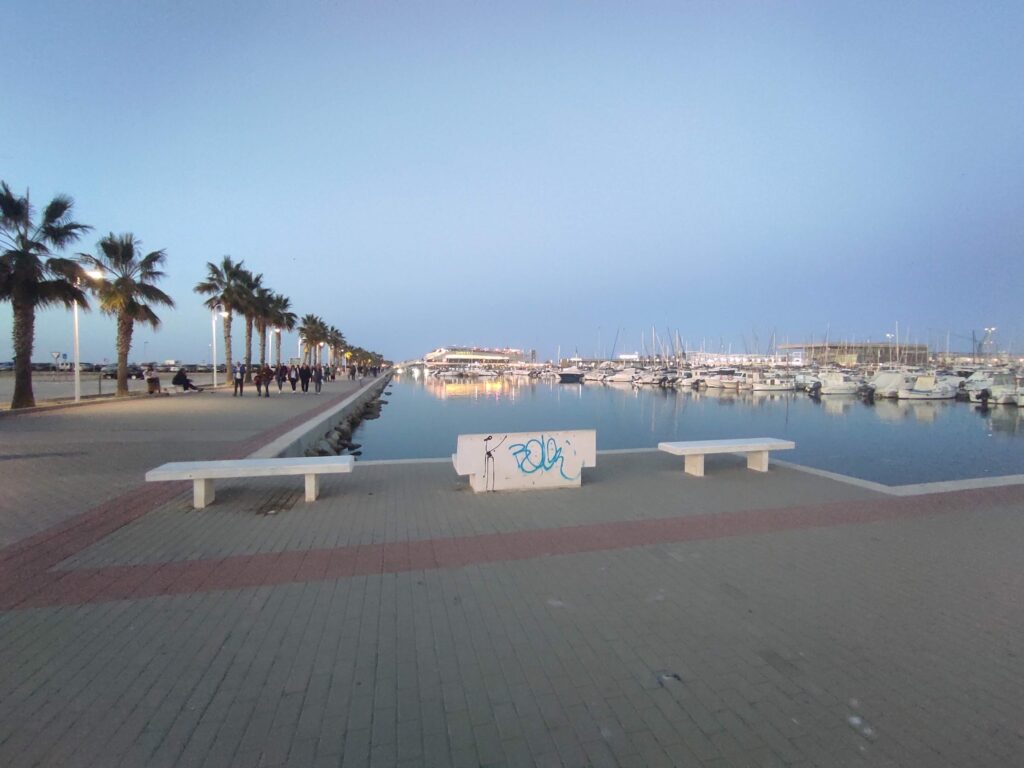
The ferry terminal in Denia is two kilometers from the city’s historic center. You can get there by taxi (about 7-8 euros) or city bus No. 2 (1.5 euros). In Ibiza, the port is within walking distance of the Old Town, which is very convenient. You step off the ferry and immediately immerse yourself in the island’s atmosphere.
From my observations, document checks and boarding take about 30-40 minutes. It’s worth arriving an hour before departure, especially if you’re traveling with a car. By the way, transporting a car will cost an additional 80-150 euros depending on its size and the season.
Modern ferries on the Ibiza Denia ferry route resemble cruise ships. Restaurants, bars, duty-free shops, children’s playgrounds, and rest areas make the journey pleasant. The flagship Balearia ferry even has a small pool on the upper deck, although it’s closed during winter months.
Why choose the Ibiza – Denia ferry?
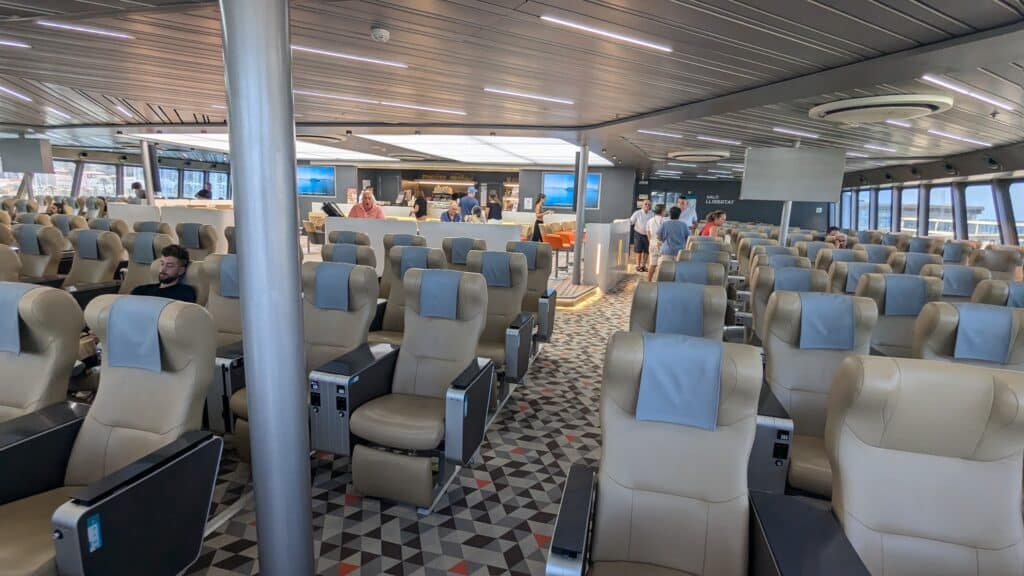
Once, I got stuck on a ferry due to a storm – the delay was 5 hours. But even this ordeal turned into an adventure! The captain personally apologized to the passengers and offered a free lunch in the restaurant. Watching the storm in the Mediterranean Sea from the height of the ferry was majestic and a bit scary. Waves resembling mountain ridges rose and fell, and the ship, like a giant cradle, swayed between them.
In 2025, Balearia launched a new onboard entertainment system. Now during long crossings, they conduct mini-tours of the ferry, explain how the ship works, and even allow peeks into the captain’s bridge.
The convenience of ferries between Ibiza and Denia is impressive. Spacious decks with loungers are arranged so that everyone can find a cozy spot with a sea view. Rest areas with soft sofas resemble the lounges of expensive hotels. According to the latest data from the Spanish tourism portal ElTurista, over 72% of passengers rate the comfort on the ferry higher than on a plane. In the office, I’m constantly glued to my work laptop, but on the ferry, I always switch off my devices. It’s easier to breathe here.
In March 2025, cafes and bars onboard updated their menus, adding traditional tapas from Valencia and signature Ibiza cocktails. Prices are higher than on shore, but quite reasonable for such service. A portion of paella costs about 15 euros, a glass of wine – from 4 euros. The most pleasant bonus is breakfast with a panoramic view of the sunrise over the sea. It’s worth splurging for such a spectacle.

Car decks are a separate topic of conversation. Transporting a car opens up opportunities to explore the Spanish coast. You drive off the ferry in Denia, and you can already reach the stunning coves of Costa Blanca or delve inland to the vineyards of Valencia. According to Denia port service statistics, in 2024 the number of passengers with personal cars increased by 23% compared to the previous year. My RAV4 fit perfectly into the ferry’s hold, although I was nervous before the first loading. Experienced staff helped position the car in a matter of minutes.
The views from the ferry are the main value of the route. My favorite time is the sunset hour, when the sun slowly sinks into the sea, painting the water surface in shades of pink and orange. Tourist drones captured this spectacle in 4K, but no video can convey the sense of freedom when you stand on the deck with a glass of sangria, and the wind tousles your hair. Some passengers specifically book evening sailings just for this show. Professional photographers often hold mini-workshops right on the deck, teaching techniques for shooting seascapes.
Time-saving is another trump card of ferry service. High-speed catamarans cover the distance between Ibiza and Denia in just 2-2.5 hours. This is practically the same as an air flight, considering the time to get to the airport, check-in, and baggage claim. The difference? You avoid stress and enjoy the journey, rather than just moving from point A to point B. These two hours on the ferry fly by unnoticed – you have time to have breakfast, take a dozen stunning photos, and even take a nap.
The environmental aspect is also worth mentioning. New vessels from Balearia, launched in early 2025, run on liquefied natural gas, reducing carbon dioxide emissions by almost 30% compared to old diesel engines. Trasmediterranea is not far behind – their fleet now includes vessels with hybrid powertrains. These innovations have made the Ibiza Denia ferry service one of the most eco-friendly in the Mediterranean, according to the European Maritime Association report for the first quarter of 2025.
Climate control on the new ferries also deserves praise. Even in the 40-degree heat of July 2024, I felt comfortable in the main lounges. Open decks are equipped with canopies and water sprayers, creating refreshing mist on particularly hot days. In winter, gentle heating allows you to enjoy the views even in cool weather.
Wi-Fi on board is no longer an issue. Since January 2025, both carrier companies have installed new generation satellite antennas. The internet speed is now sufficient for video calls and even streaming. This is important for working travelers – the three-hour journey can be spent productively.
Schedule and operators of Ibiza – Denia ferries
From my third trip, I made it a rule to check the Ibiza-Denia ferry schedule a week before departure. My first lesson was harsh: after arriving at the port of Denia following a two-hour drive from Alicante, I found out that the winter schedule for the Ibiza Denia ferry differs from the summer one. My sailing was moved to the next morning. I had to urgently find a hotel and pay double for last-minute booking. The night in an unplanned hotel cost 120 euros – a lesson I’ll remember forever.
Baleària is the main player on this route. The company has been serving the crossing for over 15 years and, according to locals, has earned a reputation as the most reliable carrier. The new ferries of 2025 include high-speed catamarans that literally fly over the waves, reducing travel time to a record 2 hours. When I last used their services in March 2025, the service reminded me of airline business class, only without the narrow seats and with the ability to go out on deck for some fresh air.
The seasonality of the schedule is key for trip planning. The difference between winter and summer schedules is striking. From June to September, ferries make up to 3-4 trips a day. Don’t forget to check Baleària’s official website, where the updated schedule is published at the beginning of each month. According to the Balearic Islands Port Authority, a record number of sailings – 112 for the month – is planned for July 2025. This is 18% more than the previous year.
From October to May, the frequency of sailings drops to 1-2 per day. On Wednesdays and Sundays, more vessels operate on the Ibiza Denia ferry route – this is related to the Spanish work week schedule, as people often use ferries for weekend trips. The frequency of departures in winter months heavily depends on weather conditions. Sailings may be canceled during storms, especially for high-speed catamarans, which are more sensitive to wave height. My winter trips often turned into a kind of lottery – will we sail or stay ashore?
Morning sailings on the Ibiza Denia ferry route usually depart between 8:00 and 11:00, and evening ones from 15:00 to 19:00. From personal experience, I can say that morning sailings are less crowded and offer an amazing opportunity to see the sea sunrise. Evening sailings allow you to enjoy the sunset – a free show for which trendy Ibiza restaurants charge 50 euros for a cocktail with a view. My favorite departure time is 16:00, a perfect balance between practicality and romance.
To check the current schedule, I use several resources. Baleària’s official website is the most reliable source, but the interface is so confusing that it’s sometimes easier to decipher Mayan hieroglyphs. Alternative options are platforms like Ferryhopper and Clickferry, which present information in a more understandable way and allow you to compare prices from different operators. According to TripAdvisor, in 2025, over 65% of tourists prefer to book tickets through these aggregators rather than directly with operators.
The golden rule of sea travel is to check the schedule twice. First when planning your trip, then 24-48 hours before departure. Ferry companies notify about changes via SMS or email, but the system has glitches. In summer 2024, over 200 passengers missed their ferry due to a last-minute pier change – notifications got stuck in corporate email. Now I call the call center the day before my trip. Five minutes on the phone save hours of trouble at the port.
It’s worth noting that many Spanish holidays affect the Ibiza-Denia ferry occupancy. May holidays, August vacations, and Christmas holidays are periods of mass movement of Spaniards between the mainland and islands. It’s best to book tickets for these dates 2-3 months in advance. A study by the España en Barco travel portal showed that ticket prices on holidays can be 40-60% higher than standard. My trip to Ibiza during the San Juan festival cost almost twice as much as usual. But what a fireworks show it was!
Besides Baleària, seasonal operators sometimes appear on the route. In summer 2025, GNV company plans to launch an experimental route with a stop in Formentera – a unique opportunity to visit two islands in one trip. The pilot project is scheduled for July-August, and if successful, may become permanent from 2026.
An interesting schedule detail – night routes. They’re not as popular among tourists but beloved by locals and budget travelers. Departure around 22:00, arrival at dawn.
How much does a ticket for the Ibiza – Denia ferry cost?
The question of ticket cost for the Ibiza-Denia ferry often confuses tourists. Many plan their budget based on outdated guidebook data. My trip in May 2025 brought a financial surprise – prices rose by 12% compared to last year. Denia port statistics confirm: the average check increased due to fleet modernization and rising fuel costs. Nevertheless, it’s still cheaper than flying if you consider overall expenses.
In basic economy class, tickets start from €60 in low season. In summer, the price jumps to €79 for a spacious cabin. VIP options with a separate lounge area and improved catering cost about €105. When the Baleària sales manager explained the difference between service classes, I grimaced. They offer better wine and wider seats for an extra €25? But after a trip in economy with two neighboring kids drumming their toys on my seat back, I changed my mind. It’s definitely worth paying extra for VIP status on board.
Seasonality affects ticket prices. In winter (October-April), you can find tickets up to 40% cheaper than in summer. Midweek is usually 10-15% more economical than weekends. My favorite trick is to book on Tuesday or Wednesday when demand is lowest. The difference between Tuesday and Saturday in August 2025 averages €23 on a standard ticket.
Early booking works wonders with the price of the Ibiza-Denia ferry. By reserving a spot 2-3 months in advance, you can save up to 30%. My sad experience of buying a ticket a day before departure in July 2024 resulted in overpaying by almost €40. Now I plan sea crossings carefully.
Vehicle transportation is a separate expense that can surprise an unprepared traveler. A motorcycle will cost about €15-25, which is barely noticeable for the budget. But a car is a different story. A standard passenger car starts from €110 in the low season and can reach €185 in August. Size matters – for an SUV or minivan, you’ll have to pay an extra €30-50. My Toyota RAV4 was classified as a “medium-sized car” – €135 round trip in May 2025.
The ferries operate a discount system. Children from 4 to 12 years old pay 50% of the cost, toddlers under 4 travel for free. Residents of the Balearic Islands are entitled to a 75% government discount – the Spanish government subsidizes local residents’ travel between the mainland and the islands. Tourists can only envy this. Baleària Plus cardholders (the company’s loyalty program) receive 5-10% cashback on future trips. After my fourth trip, I finally registered for the program – the accumulated points covered almost a third of the fifth ticket.
Where to buy tickets is a strategic question. The official Baleària website offers the most up-to-date data, but the interface resembles an old phone directory – informative but inconvenient. Aggregator platforms like Ferryhopper and Clickferry compare prices from different operators and offer a more user-friendly booking process. A study by the Spanish consumer magazine OCU showed that Ferryhopper offers prices 3-7% lower than on carrier websites in 62% of cases. They receive commission from ferry companies, not passengers. I prefer to book through Ferryhopper.
Hidden costs can spoil the impression of even the most advantageous Ibiza-Denia ferry rate. Many forget to account for luggage costs. Although the basic fare includes up to 20 kg per person, each additional kilogram will cost €1-2. My suitcase full of souvenirs after two weeks in Ibiza incurred a €15 surcharge. Changing the travel date is another unexpected expense. The fee is €10 if done 48 hours before departure, and €30 in the last 24 hours.
On-board dining is a separate expense. An average lunch in the ferry’s restaurant will cost €12-18, drinks range from €2 for non-alcoholic to €6-8 for wine or beer. Thrifty Spaniards and experienced tourists bring their own food – it’s not prohibited by transport rules. I always bring a thermos with hot coffee and a ham sandwich – saving about €15 on each crossing. On longer overnight trips, food costs can add €30-40 per person to the travel budget.
Cabins – luxury or necessity? On night routes, the question answers itself. An interior cabin will cost from €80 in winter to €130 in summer. An exterior cabin with a window costs €25-40 more.
Departure and arrival ports: Ibiza and Denia
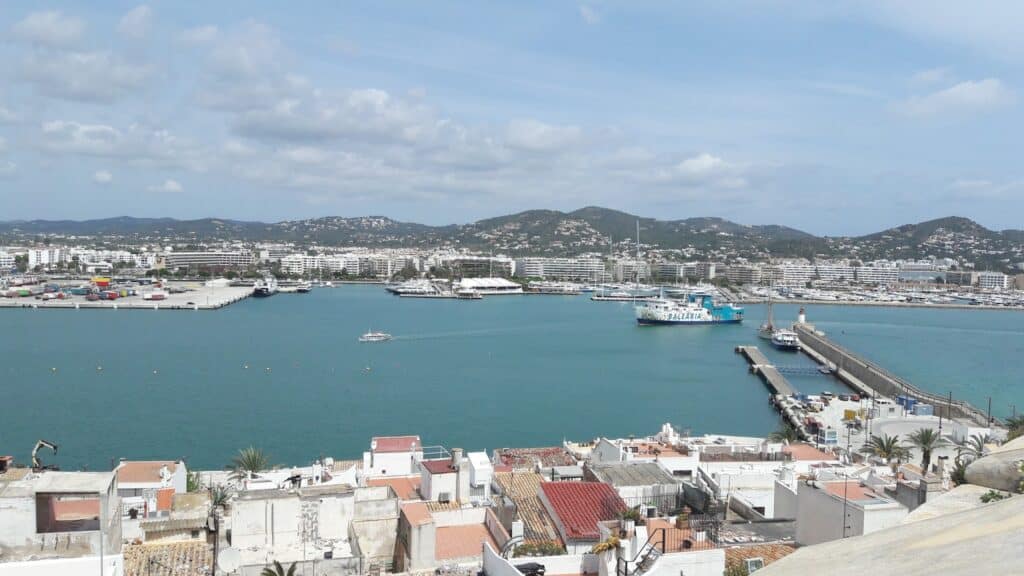
Three years ago, my feet first touched the pier of Ibiza’s port. Palm trees rustled welcomingly, and the seagulls seemed more relaxed than the businesslike ones back home. The port was just a transit point for me then, until I discovered the Ibiza Denia ferry route – a convenient alternative to flying.
Ibiza’s port is literally within walking distance from the Old Town, located on Avenida de Santa Eulària. The first time, I spent 20 minutes looking for a taxi until a local bartender laughed and pointed around the corner: “Just go straight.” Indeed, you can walk from the historic center to the terminal in 10-15 minutes, admiring millionaires’ yachts along the way.
For those living further from the center, buses #10 and #12 run to the port. They’re packed during peak season, with tickets costing just 1.5 euros.
I remember my surprise when, instead of a shabby waiting room, I saw a modern complex with panoramic windows. After the 2023 renovation, Ibiza’s port turned into a mini-shopping center with air-conditioned waiting areas and free Wi-Fi. Technical work was completed in spring 2025 with the installation of new information boards and an updated check-in area. Three cafes offer decent croissants and excellent coffee for 2.5 euros an espresso. My personal test: if the barista draws on the foam, you’re in the right place. Duty-free shops fleece you, but souvenir shops delight with prices even in high season.
A taxi from Ibiza port to the airport costs about 20 euros. My life hack: use the Cabify app to book a car in advance.
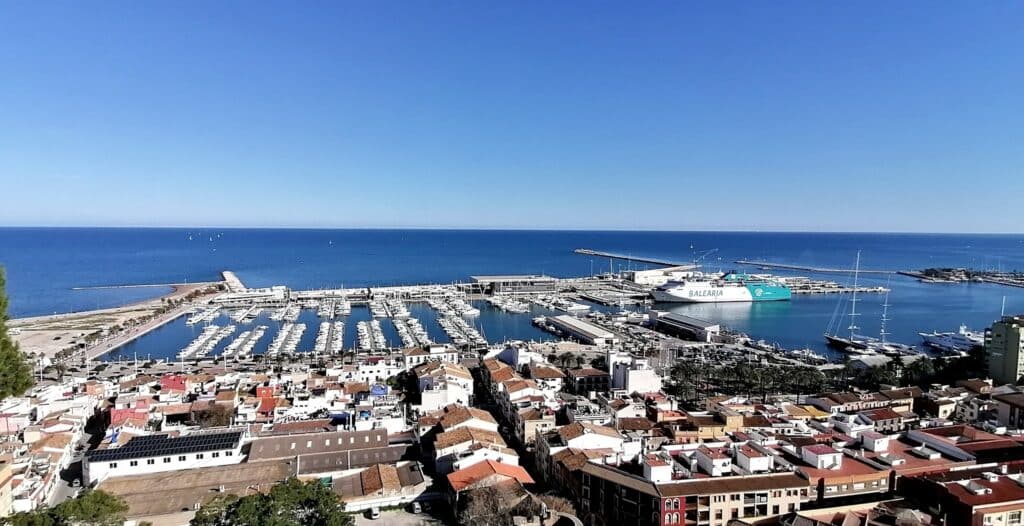
On the mainland side, Denia’s port looks more business-like and less touristy. The Estación Marítima sea terminal is two kilometers from the city center, in the industrial port area. The first time, I missed the right turn and drove an extra five kilometers. Since 2024, signs to the ferry terminal have been updated, making them more visible, but navigation systems still get confused sometimes.
You can get from Denia’s center to the port by bus #2 (runs every 30 minutes, costs 1.5 euros) or taxi (7-9 euros). If you have a car, it’s better to set your navigator to “Puerto de Denia Terminal de Pasajeros” – this way you’ll reach the right terminal, not the cargo docks, as happened to me the first time. According to Denia’s port administration, in 2024 they expanded the parking lot, adding 150 new spaces, which solved the parking problem during high season.
Denia port’s amenities are more modest than Ibiza’s, but quite functional. The information desk operates from 8:00 to 20:00. A young woman speaking four languages patiently explained the intricacies of the Ibiza Denia ferry service to me, even in my broken Spanish. The waiting area has vending machines with cold drinks and snacks. “El Puerto” cafe offers simple but tasty Spanish dishes at reasonable prices: calamari for 8 euros, paella for 12. A ham sandwich and coffee will cost 6-7 euros.
In February 2025, a new service center opened at the port of Denia. Here they provide luggage storage services (5 euros per item for 24 hours), sell basic tourist supplies, and even have showers for those arriving on night trips. I used these services when my hotel wasn’t ready for early check-in – it saved my backpack and my mood. The most common mistake for newcomers is arriving late to the port.
The experience of three missed departures taught me an iron rule for the Ibiza Denia ferry route: arrive at the port at least an hour before departure, and if traveling with a car – an hour and a half. The car loading procedure begins 45 minutes before the scheduled departure time. They don’t wait for latecomers – the ferry leaves on schedule even if there’s a family with three children crying on the pier, who rushed through Denia’s narrow streets hoping to make it.
My personal ritual before boarding is a cup of coffee with a sea view and a quick review of the route upon arrival. At Ibiza port, the “Marina Botafoch” cafe offers a terrace with the best view of the harbor. In Denia, there’s no terrace, but you can walk to the viewing platform five minutes from the terminal. According to Denia’s tourist office, this panoramic view is among the top ten most photographed places in Alicante province. In 2024, they installed new benches and information stands about local maritime history there.
What to take with you on the Ibiza – Denia ferry?
My suitcase always includes the perfect kit for a sea journey, capable of turning an ordinary crossing into a pleasant trip. There’s nothing sadder than seeing a tourist glued to their smartphone screen with 5% battery while the Mediterranean Sea spreads out beyond the window. In 2025, companies expanded the list of allowable items on board, opening up new possibilities for comfortable travel.
Documents are the holy grail of any traveler. Once, I forgot my passport and spent 60 euros on a taxi to the hotel and back. On the Ibiza Denia ferry route, a European ID card is sufficient, but for non-Europeans, a passport is mandatory. In 2024 alone, over 120 passengers missed the ferry due to document issues.
It’s better to print tickets – saves time during check-in.
Motion sickness remedies should be kept in the most accessible pocket – you might need them. Dramamine is my faithful companion. According to Baleària’s medical service, about 15% of passengers experience seasickness symptoms, especially in rough seas. My recommendation is to take a pill 30 minutes before departure, even if you feel like a seasoned sailor.
In the summer of 2024, I witnessed a family with children forget sunscreen and get impressive burns on the open deck. The Mediterranean sun is merciless. The UV index in these latitudes reaches 9-10 even on cloudy days. A bottle of SPF 50 and a sun hat are not luxuries, but basic protection. When traveling in winter, don’t forget a windbreaker – the wind on open decks cuts to the bone.
Food on board the Ibiza Denia ferry is a whole chapter of my sea adventures. After my first trip and the shock of cafe prices (7 euros for a tiny sandwich – seriously?), I made it a rule to bring my own snacks. A thermos with hot tea saved me during winter crossings. Ham sandwiches bought at a local bakery cost three times less than the onboard menu. But I still prefer to buy wine on the ferry – local varieties are served in proper glasses with a sunset view.
Electronics and battery charge are the bane of modern travelers. On new Baleària ferries, the number of outlets has doubled, but during peak season they’re often occupied. My lifesaving kit: a 10000 mAh power bank, a short cable, and an adapter with multiple USB ports. When I found a free outlet in a far corner of the lounge, a queue of five people with pleading eyes formed behind me. I had to organize a collective charging station – that’s how I met a family from Barcelona who later invited me to dinner.
Entertainment for the sea crossing is a matter of taste. A loaded tablet saved me from boredom during a delay due to technical problems in March 2025. A book can’t replace the sea outside the window, but it becomes the perfect companion when your eyes tire from the blinding sun. Travel magazines read differently on a ferry – as if the text comes alive overboard. And for children, I recommend bringing coloring books and pencils – they’re quieter than a tablet and don’t need charging.
Noise-cancelling headphones cut out engine noise and children’s crying.
Practical clothing on a ferry means layers that you can add or remove. The temperature in different parts of the ship can vary by 10 degrees. Powerful air conditioners work in the enclosed lounge, while on the open deck under the Spanish sun you can get heat stroke. My outfit for a comfortable journey: light trousers (not shorts – seats can be sticky), a T-shirt, a light shirt, and a windbreaker. Weather forecasts at sea are available through the Baleària app – technology I appreciated during an unexpected thunderstorm.
Footwear should be closed and non-slip. My first flip-flops nearly sent me into the saltwater pool – decks turn into ice rinks after rain. Comfortable sneakers with rubber soles became my standard for the Ibiza Denia ferry route. They also make it easier to move between decks on steep stairs. A recent ferry safety study showed that 65% of minor injuries occur due to inappropriate footwear.
It’s better to bring a seasickness bag even if you’ve never suffered from motion sickness. In January 2025, during a storm, I was the only one who had spare bags – I had to hand them out to neighbors. Later, Baleària staff explained: supplies of such bags on board often run out in bad weather.

